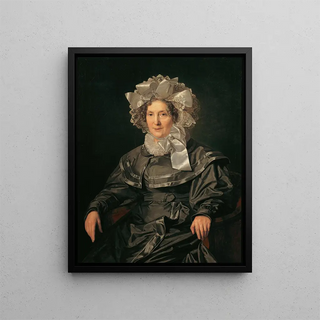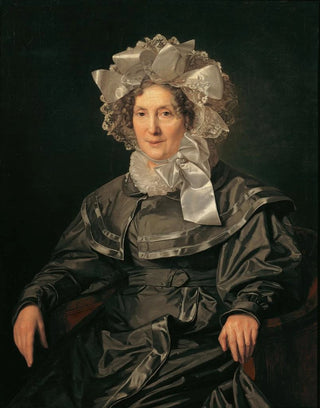Art print | Elisabeth Waldmüller, the artist's mother - Ferdinand Georg Waldmüller


View from behind

Frame (optional)
Elisabeth Waldmüller Art print, the artist's mother - Ferdinand Georg Waldmüller – Engaging introduction
In the world of art, some works transcend the mere frame to become living witnesses of an era, a culture, and a personal history. "Elisabeth Waldmüller, the artist's mother - Ferdinand Georg Waldmüller" is one such piece. Painted by Ferdinand Georg Waldmüller, a master of 19th-century portraiture, this depiction of his mother embodies not only a filial homage but also a reflection on family values and the individual's place within society. Through this painting, the artist manages to capture the very essence of his mother, while offering a glimpse into the psychological nuances that characterize his subjects.
Style and uniqueness of the work
The strength of this piece lies in how Waldmüller blends realism and emotion. Elisabeth's gaze, both gentle and determined, seems to tell a story far deeper than that of her simple portrait. The meticulous details of her face, the textures of her clothing, as well as the carefully orchestrated lighting, testify to unparalleled technical mastery. Waldmüller does not merely reproduce his mother's physical appearance; he succeeds in conveying an intimate, almost tangible atmosphere. The composition, carefully balanced, draws the eye toward the face of the maternal figure, while revealing elements of her environment, symbols of her role in the artist's life. Thus, each brushstroke contributes to the development of a visual narrative, where emotion and technique intertwine with rare elegance.
The artist and his influence
Ferdinand Georg Waldmüller is often celebrated as one of the pioneers of realism in painting. Born in 1793 in Vienna, he developed a unique style that combines academic tradition with modern sensitivity. His approach is distinguished by a particular attention to the psychology of characters, as well as to light and color. Waldmüller’s work is marked by a desire to depict daily life and human relationships with disarming sincerity. By painting his mother, he does not merely illustrate a personal bond;

Matte finish

View from behind

Frame (optional)
Elisabeth Waldmüller Art print, the artist's mother - Ferdinand Georg Waldmüller – Engaging introduction
In the world of art, some works transcend the mere frame to become living witnesses of an era, a culture, and a personal history. "Elisabeth Waldmüller, the artist's mother - Ferdinand Georg Waldmüller" is one such piece. Painted by Ferdinand Georg Waldmüller, a master of 19th-century portraiture, this depiction of his mother embodies not only a filial homage but also a reflection on family values and the individual's place within society. Through this painting, the artist manages to capture the very essence of his mother, while offering a glimpse into the psychological nuances that characterize his subjects.
Style and uniqueness of the work
The strength of this piece lies in how Waldmüller blends realism and emotion. Elisabeth's gaze, both gentle and determined, seems to tell a story far deeper than that of her simple portrait. The meticulous details of her face, the textures of her clothing, as well as the carefully orchestrated lighting, testify to unparalleled technical mastery. Waldmüller does not merely reproduce his mother's physical appearance; he succeeds in conveying an intimate, almost tangible atmosphere. The composition, carefully balanced, draws the eye toward the face of the maternal figure, while revealing elements of her environment, symbols of her role in the artist's life. Thus, each brushstroke contributes to the development of a visual narrative, where emotion and technique intertwine with rare elegance.
The artist and his influence
Ferdinand Georg Waldmüller is often celebrated as one of the pioneers of realism in painting. Born in 1793 in Vienna, he developed a unique style that combines academic tradition with modern sensitivity. His approach is distinguished by a particular attention to the psychology of characters, as well as to light and color. Waldmüller’s work is marked by a desire to depict daily life and human relationships with disarming sincerity. By painting his mother, he does not merely illustrate a personal bond;






